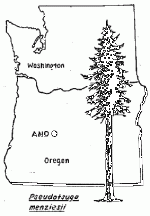Andrews Forest LTER enters its second decade with a flurry of research activity, facilities development, and extensive involvement with the forest management debate reverberating across the Pacific Northwest.
Decomposition
Several recent Andrews Forest research projects have concerned decomposition and change in carbon stores in terrestrial ecosystems. Using extensive vegetation data sets and analysis of the fate of carbon on the site and in logs leaving the site, Mark Harmon, Bill Ferrell, and Jerry Franklin modeled effects on carbon budgets of conversion of old-growth forests to intensively managed forests.
They found a net loss of 300 tons per hectare of carbon over the first 60 years after cutting. These calculations suggest that conversion from natural to managed forest in the conifer biome of the Pacific Northwest may account for 2+% of the increase in atmospheric CO2 arising from all land use in the past century.
Mark Harmon has also managed the establishment of the LTER intersite litter decomposition experiment in which leaf litter of 25 species is exchanged among the 17 LTER sites plus four additional sites. This study has a 10-year design life and represents the first time that a full suite of site and experimental variables are collected in a coordinated fashion over such a broad array of environments and litter types. The information will be useful in modeling leaf and fine root decomposition on the global scale.
Cooperative Projects
Other recent research includes: a cooperative project with Dean Urban (University of Virginia) and the EPA Global Change Program to model the response of forests west of the crest of the Cascade Range to climate change using the gap model ZELIG; detailed analysis of spatial variability of soil (nitrogen, microbial biomass, invertebrates, etc.) and vegetation properties in natural forest stands of 100 and 500 year ages; modeling of the input of coarse woody debris to streams; and a cooperative project with U.S. Geologial Survey to model streamflow at a landscape scale.
New Personnel
Several post-docs recently joined the Andrews LTER project. Steve Hart (University of California, Berkeley) has been working with Dave Perry and Phil Sollins on nitrogen cycling in forest soil and decaying logs. Donna D’Angelo (Virginia Polytechnic Institute), who recently worked on nutrient cycling in streams at the Coweeta LTER site, is helping Stan Gregory and Gary Lamberti (University of Notre Dame) initiate a stream nutrient enrichment study designed for comparison with a similar study on the Kuparuk River at the Arctic Tundra LTER site.
Facilities Upgrade
Andrews LTER facilities are being substantially upgraded. Funds from the U.S. Forest Service and NSF will make it possible to replace several decrepit trailers with two 4,000-square-foot bunkhouses for researchers in the field. Oregon State University, NSF and Forest Service funds have supported installation of a Sun-based computing system, a local area network, and a GIS laboratory.
Results Gain Prominence
In the past year results and implications of Andrews-based research over the past two decades have gained great prominence through the current controversy over management of the remaining old-growth forest in the Pacific Northwest. Basic esoteric research topics of the 1970s and early 1980s, such as the ecology of old-growth forests and northern spotted owls, are major political and social issues in 1990. Andrews scientists and U.S. Forest Service land management colleagues have developed and implemented alternative approaches to management of forest stands, forest cutting patterns, and stream and riparian networks--practices which are based on the results of ecosystem research at both stand and landscape scales.
Site personnel now conduct nearly 100 tours a year to view examples of the spectrum from basic research studies to application on Forest Service lands. Audiences include members of Congress, other elected officials, their staffs, students, educators, land managers, and news media.
For additional information contact Fred Swanson or Art McKee, Forestry Sciences Lab, 3200 Jefferson Way, Corvallis, OR 97331.

 Enlarge this image
Enlarge this image